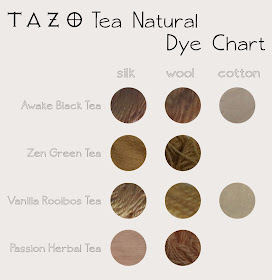Fun fact! Tannin is also found in cattle dung and urine, so early dyers would often "animalize" their fabric by soaking the fabric in these tannin rich materials.
Okay now that I have slightly grossed you out, let's move back to dyeing with lovely smelling tea! You can dye using unused tea bags or you can dye with the used tea after a nice cuppa (look at me being so british), the latter of course takes much longer. There are so many different varieties of tea, which means that there are as many dye colors as there are tea brands and flavors, and if you can get into the realm of mixing various teas, the possibilities become endless! For my tea dying experiments I used the common Tazo tea brand. Tazo tea is a division of Starbucks, and as you can only imagine, Starbucks goes through tons of Tazo tea! Being a Starbucks employee, I was able to get my hands on large amounts of used tea bags, and I have been saving them up for these tea dyeing experiments. Below is a bit about the tea itself, from my old Tazo tea Starbucks passport.
I was able to dye using the English Awake Black tea, Zen Green tea, Vanilla Rooibos Tea and Passion Herbal tea. To get the deep colors, I mordanted the silk and wool with Alum and the cotton samples with Alum Acetate. I then prepared a dye bath with the tea. I placed about a cup of dry tea in a nude stocking and submerged it in the pot with enough water to cover the dye stuff. I then simmered the dye and dye stuff for a good hour. I was dying a silk scarf and small samples, so you may want to adjust the amount of tea for the dye bath based on the about of dye stuff you have. In the chart below, you can see how you can get a variety of natural colors ranging from pinks, browns and olive greens from these four teas. As usual, these colors achieved from natural dyeing methods are much more vibrant and have much more depth to them when compared to commercial dyes.
 |
| Select pages from the Tazo Tea Passport for Starbucks baristas. |
I made quite a few scarves using these beautiful natural colors as the base to my scarf designs, and then I painted with natural colors on top of the silk scarves. I will post some photos of the finished scarves, once I locate my sister and get her to sit still for more than an hour to be a model for a photo shoot. This may be too difficult so you guys may have to deal with scarves on the mannequin.
Helpful Natural Tea Dyeing Sources:
XOXO


Great inspiration! I'm excited to see the dyed scarves!!! ~ Jamie
ReplyDeletevery interesting this post. thanks for informations
ReplyDeletechamomile tea is very good tea